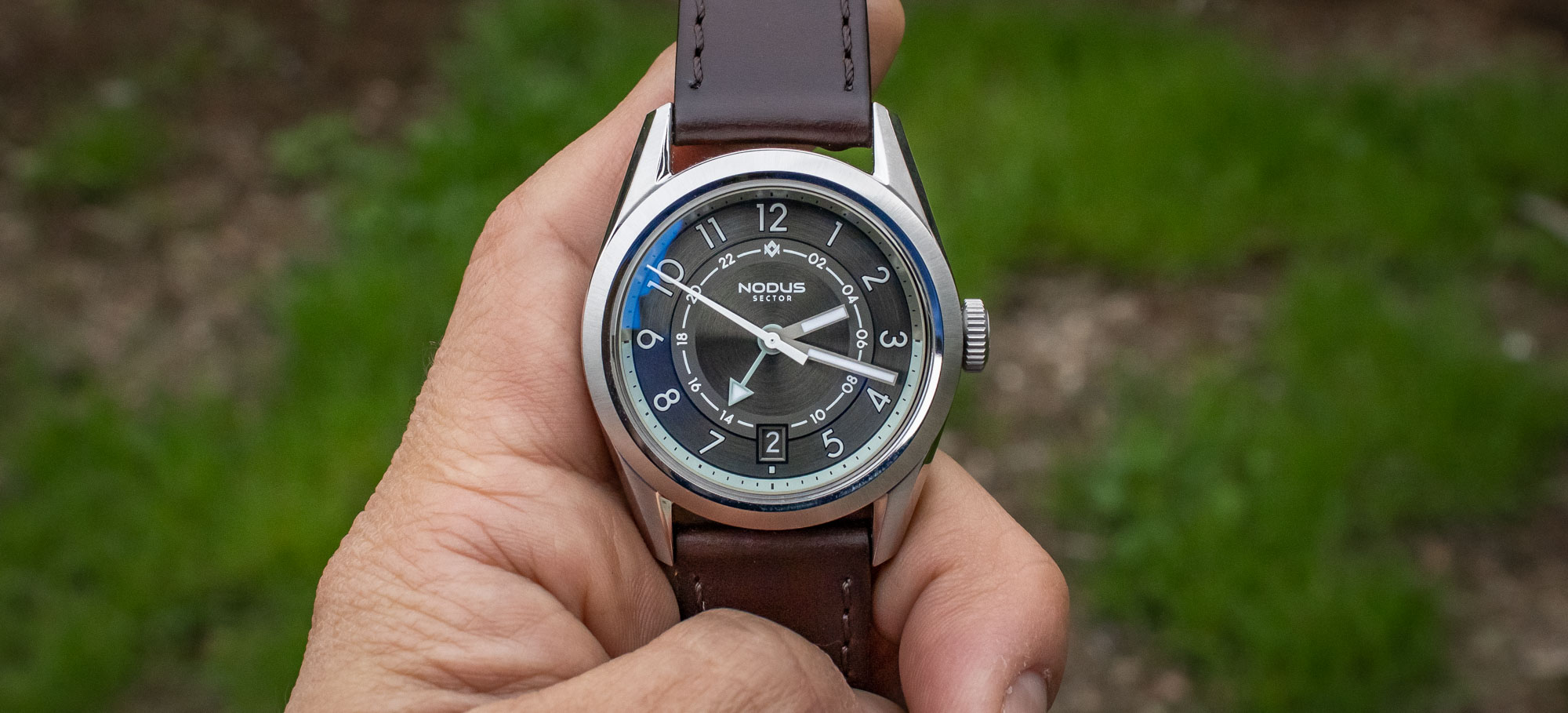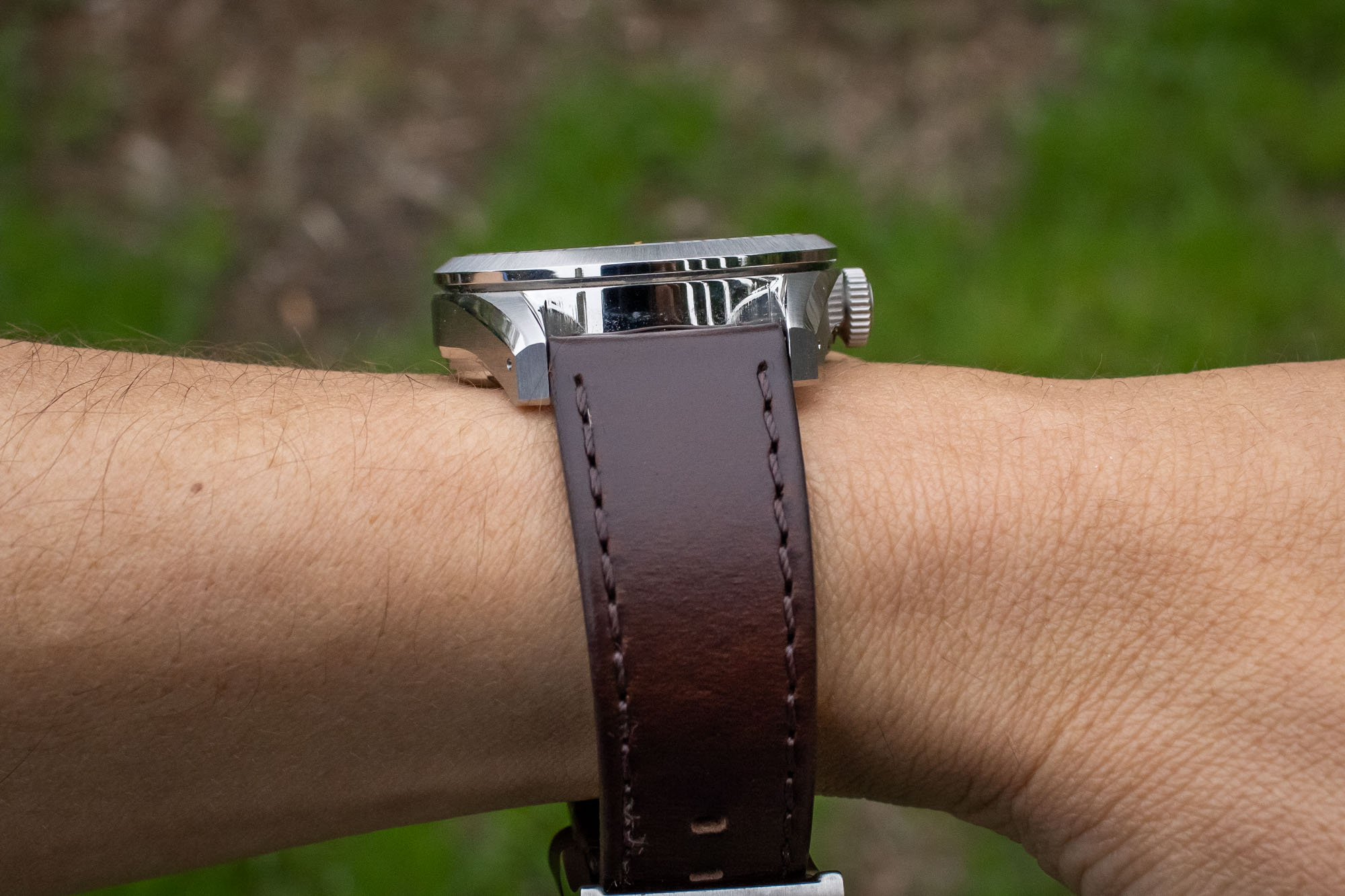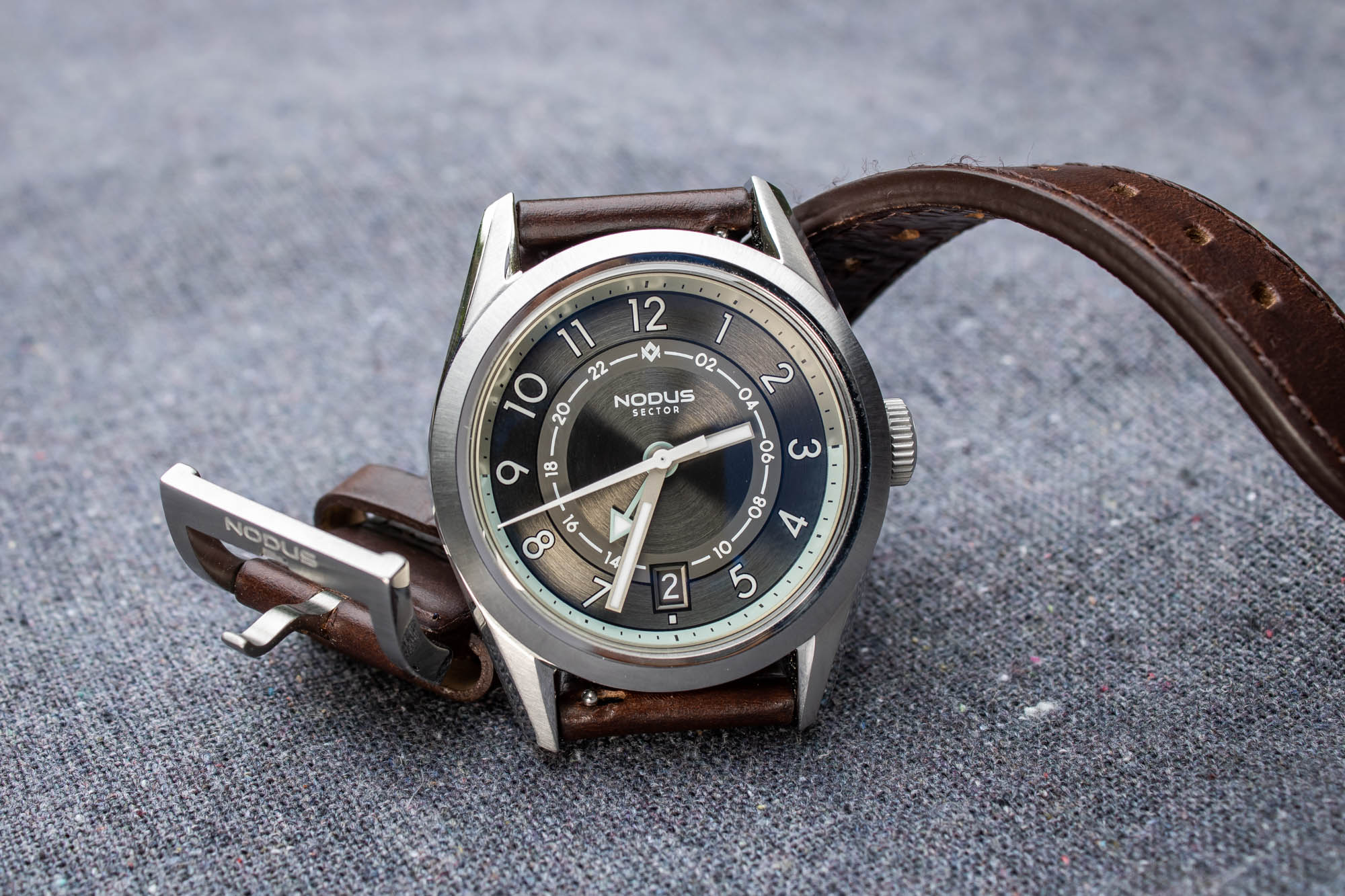
One of the bigger game-changers of 2022 was Seiko creating a proper GMT movement with independently adjustable hands for the masses. While the Seiko 5 GMT that first showcased this new caliber was certainly a noteworthy release, the bigger news was the actual movement itself, as it meant that many of the industry’s favorite small-scale independent brands would soon be able to create affordable GMT watches of their own, without having to opt for a costly Swiss caliber and forcing a higher price point. Based in Los Angeles, California, Nodus is one of my favorite small-scale independent brands currently operating at a price point below a thousand dollars. While Nodus has produced dual-time watches before that used traditional three-handed movements paired with rotating 12-hour bezels, the Nodus Sector GMT is the brand’s first proper four-handed GMT watch, and it offers versatile aesthetics, highly respectable specifications, and surprisingly good finishing — all at a very compelling price point that even comes in below what Seiko charges for its own budget-friendly GMT watch.
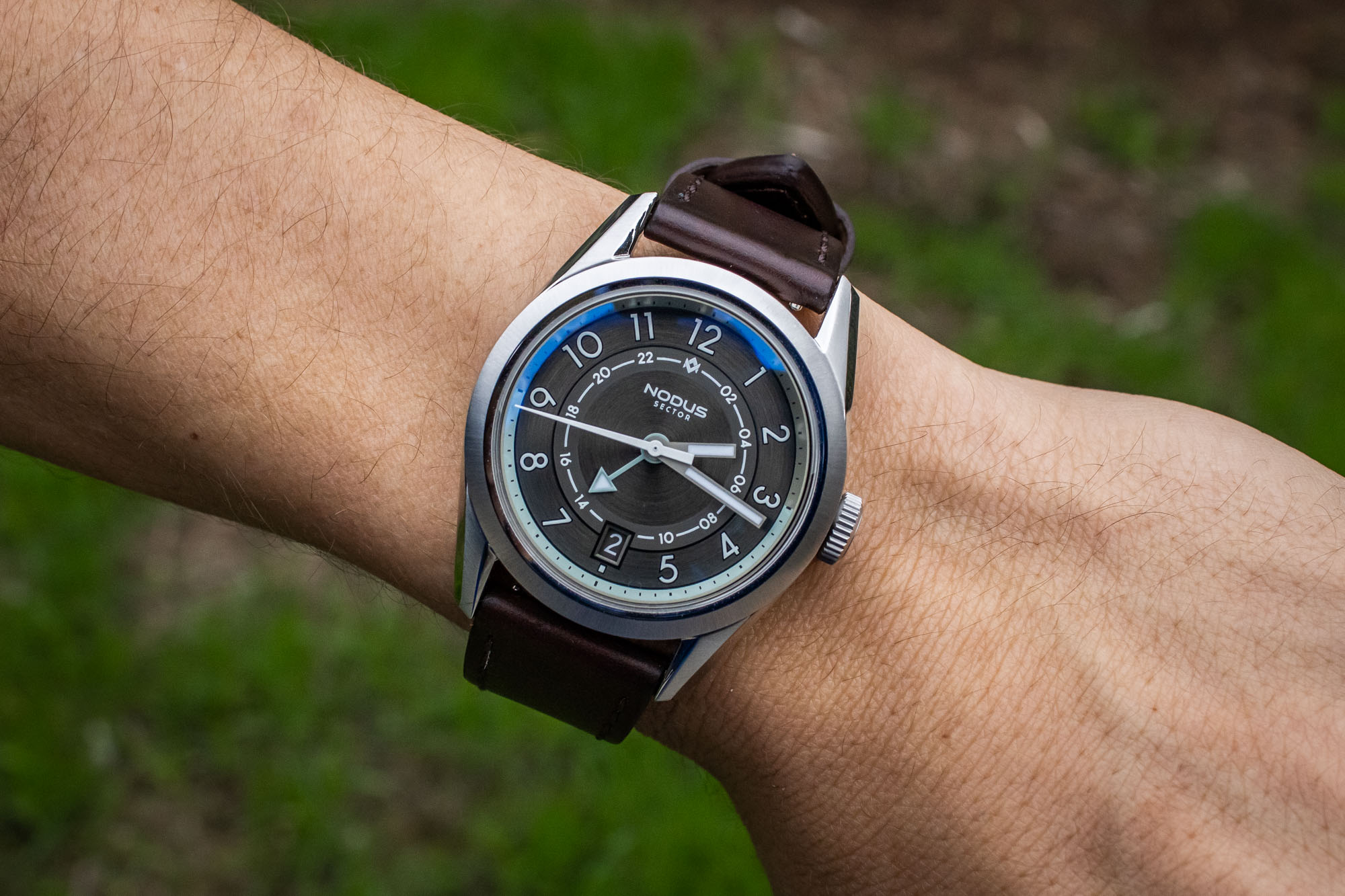
A lot of brands follow Rolex’s core blueprint for their GMT watch designs, which consists of a highly sporty package that uses an external rotating bezel to contain the obligatory 24-hour scale. While there is nothing wrong with this design and it is ultimately quite functional, having an external rotating bezel does commit the watch to having an inherently rather sporty or tool-oriented overall aesthetic. Even as someone who sometimes travels to do sporty outdoor things, I also frequently go on trips where I will need to put on a shirt with a collar and look relatively presentable at some point, and I always thought that it was slightly surprising that so many GMT watches embraced firmly sporty aesthetics, when the most active thing their owners will likely be doing while traveling is going on a day hike, lounging at the beach, or going for a quick swim in the hotel pool.
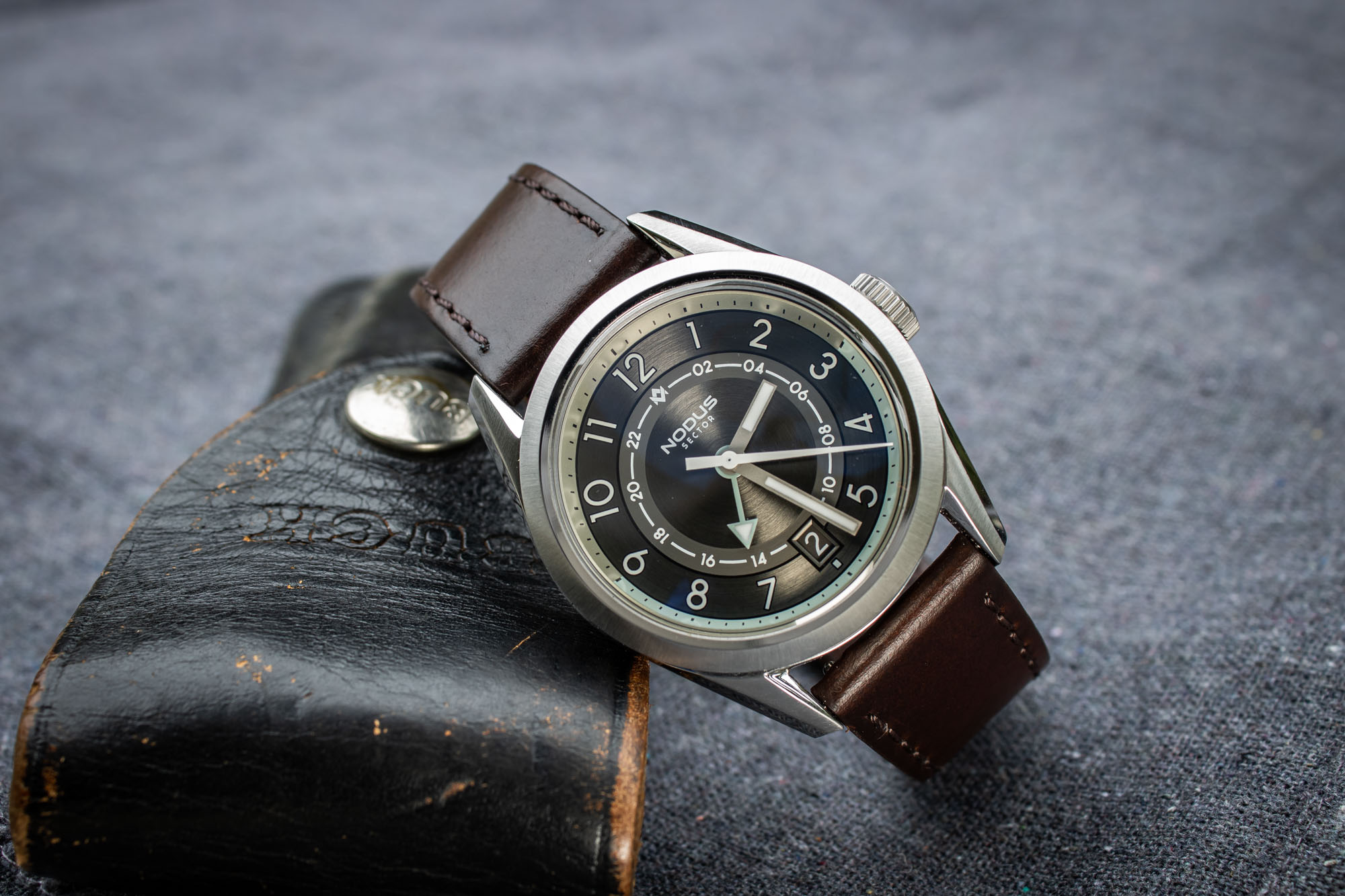
While there is certainly a case to be made for having a travel watch that is rugged enough to stand up to the hectic environments of airport security checkpoints and with enough water resistance to go for a quick swim, a GMT watch with a simple smooth bezel and a 24-hour scale printed upon its dial arguably lends itself to significantly greater aesthetic versatility. This statement applies even more when it comes to the GMT watches that are used to track additional timezones but not actually used for travel, as many of these watches won’t face anything more demanding than a tense boardroom discussion or refilling the office water cooler.
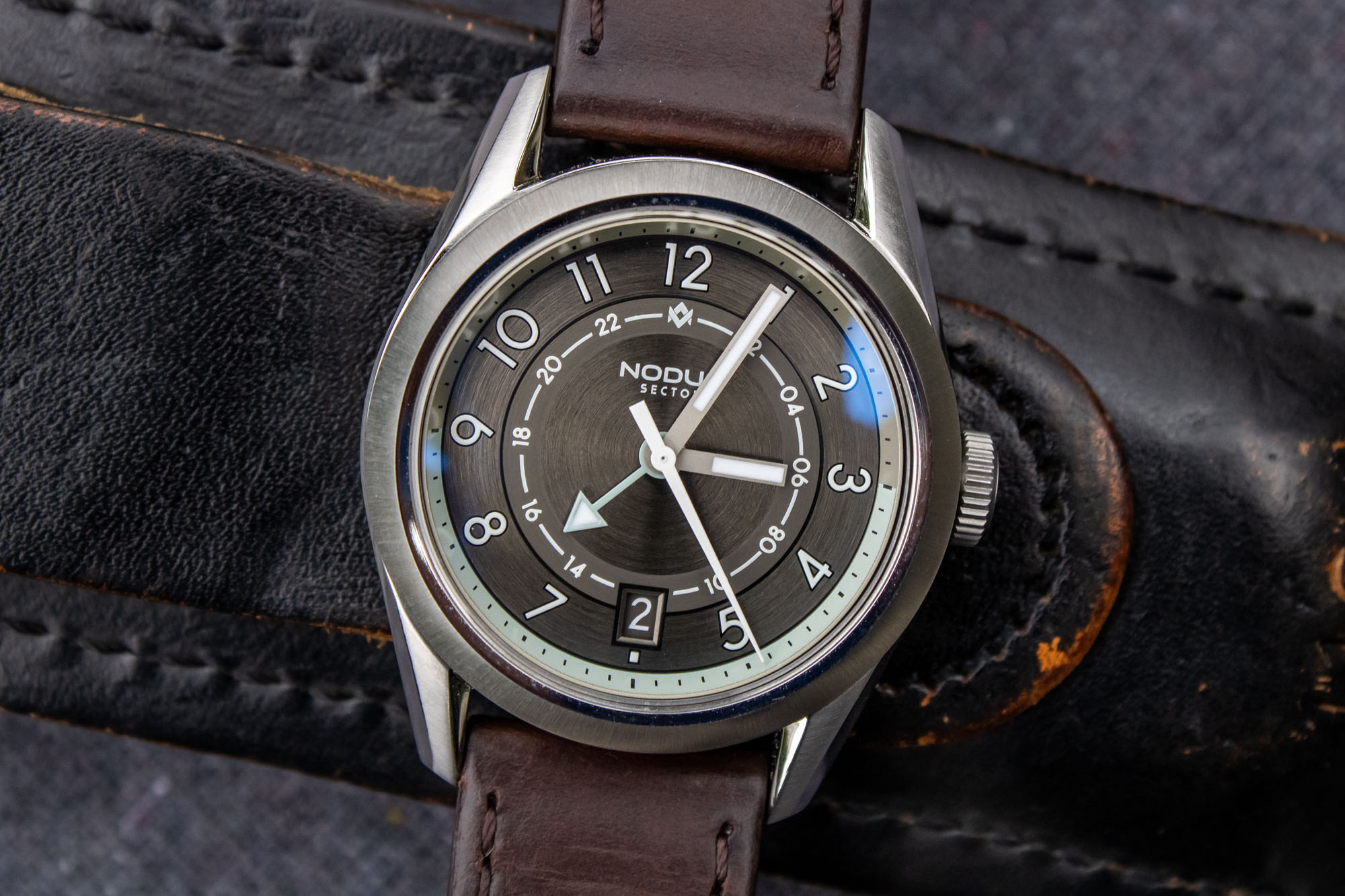
Given that Nodus frequently makes sleek yet capable sports watches, it’s almost a surprise to see that the brand’s inaugural GMT watch offers one of the more refined designs currently available in its catalog. That said, the Nodus Sector GMT is also certainly not a dress watch, and since it is ultimately part of the greater Sector series, it uses the same dynamic and aesthetically versatile middle case that allows it to easily exist in a wide variety of different situations. All Nodus Sector watches are immediately identifiable as being part of the same collection due to the shared lines of their middle case, although with different dials, hands, bezels, and crowns, each one has its own unique identity.
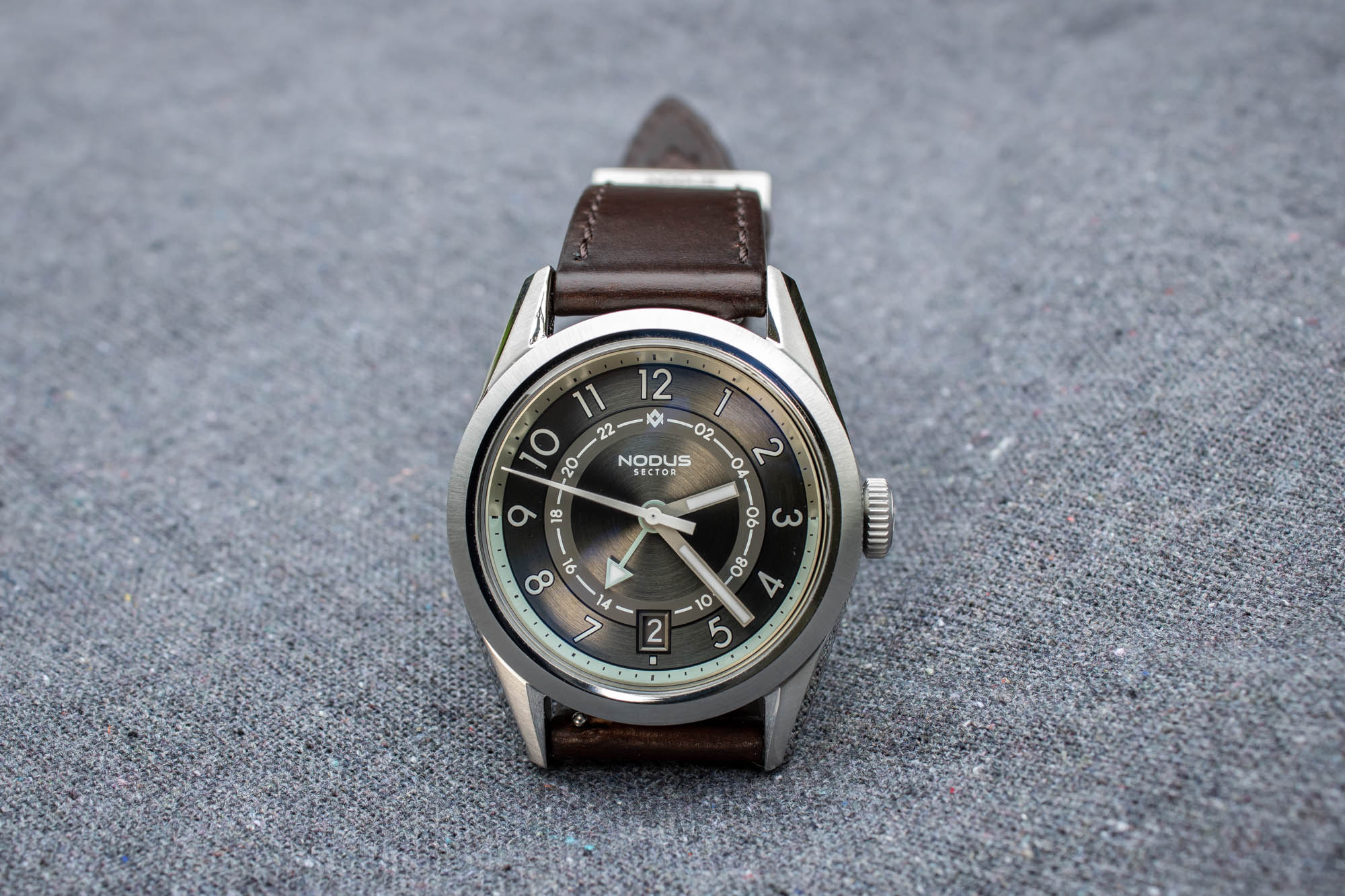
The overall aesthetic of the Nodus Sector GMT could best be described as a modern and refined version of a classic field watch that includes a subtle yet practical dual-timezone display. At the time of launch, Nodus offers the Sector GMT in two different colorways: Pacific, which consists of a deep blue dial with golden yellow accents; and Metro, which is the version pictured here that embraces a largely gray and white color profile with small pale blue highlights. While the Metro colorway is slightly more refined and formal than its Pacific sibling, both versions of the Sector GMT offer highly versatile designs that perfectly lend themselves to everyday wear and use.
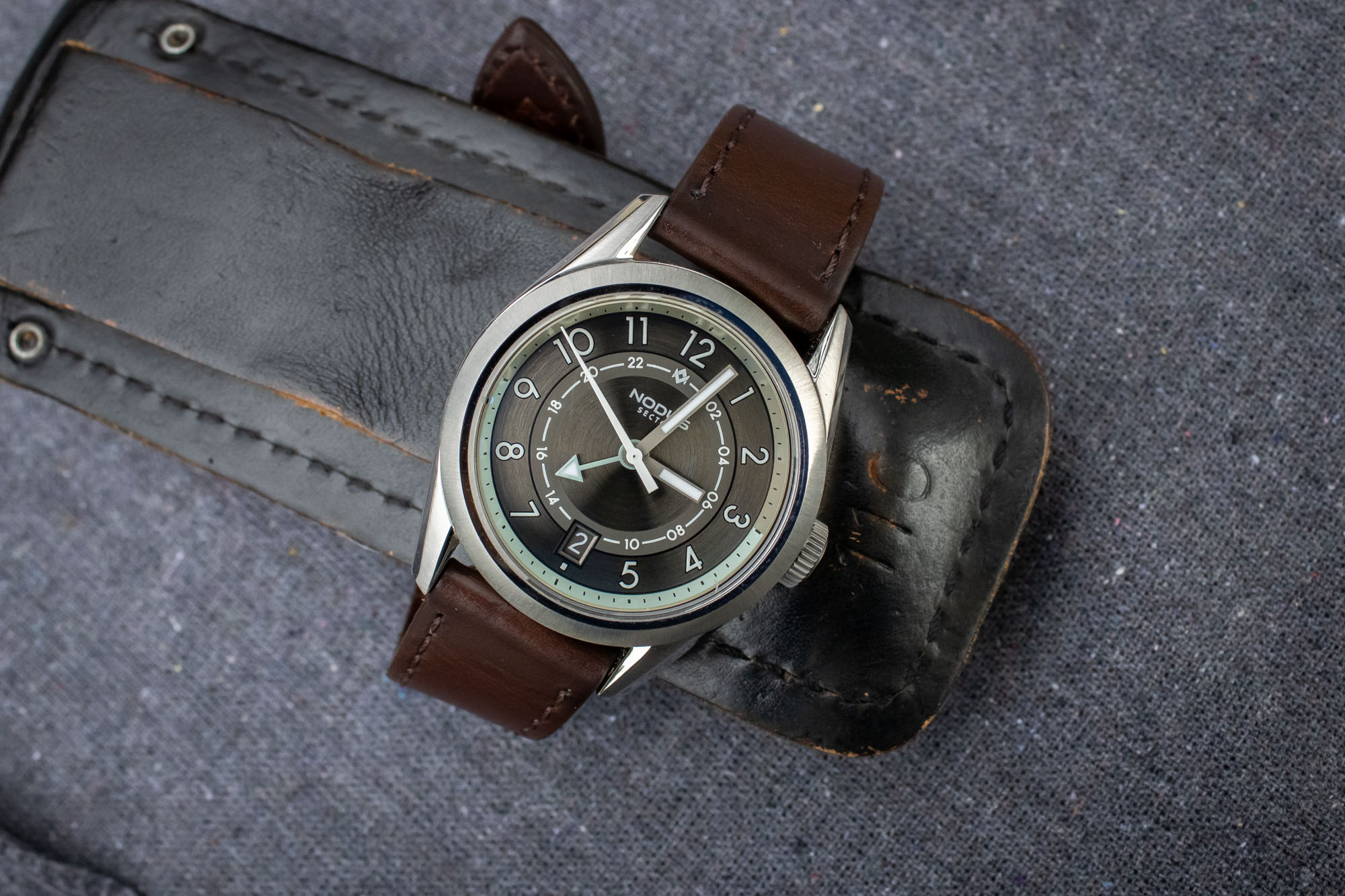
Crafted from 316L stainless steel, the underlying case profile of the Nodus Sector GMT will be immediately familiar to those who have prior experience with other models from the Sector collection. That said, both the bezel and crown are different on the new GMT version, which ultimately give it a slightly different overall appearance compared to its siblings that share the same middle case design. The case itself measures 38mm in diameter by 12.25mm-thick, with lugs that are set 20mm apart and an overall lug-to-lug profile of 47mm. The lugs feature drilled holes and are rather long and prominent relative to the fairly compact diameter of the watch. However, they also feature a curved profile, which lets them hug the wrist and prevents them from feeling too large or disproportional in relation to the rest of the case.
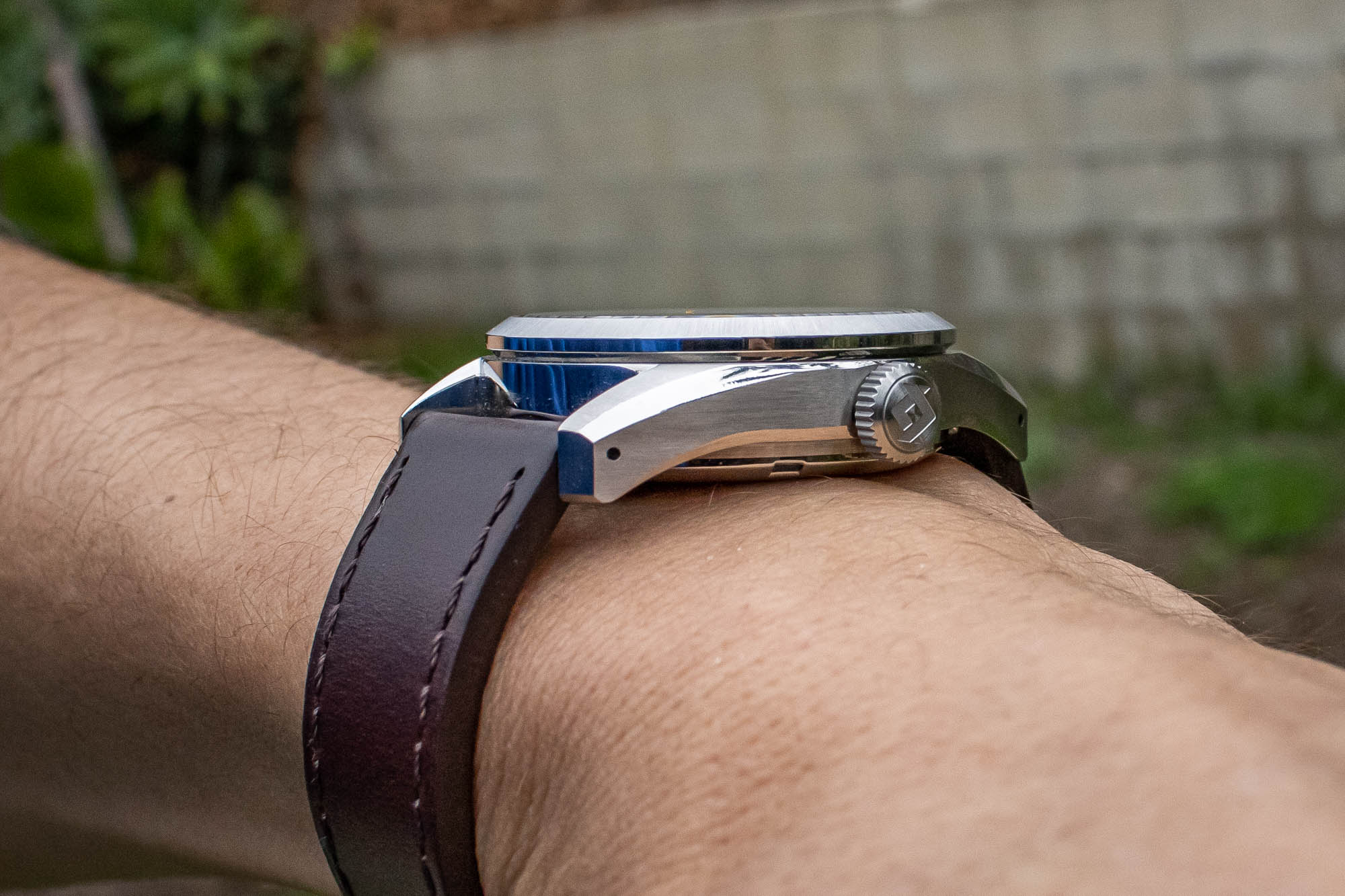
Just like other models from the Sector series, the lugs feature an almost twisted design, with large polished bevels on the outer surface and prominent facets on the inner edges. Contrasting against the high-polished elements are brushed top surfaces for the lugs, along with horizontal brushing on the sides of the case. What is most interesting about the brushing featured on the Nodus Sector GMT is that the actual length of the brush strokes themselves become longer as they move towards the tips of the lugs from the center of the case. The effect is subtle, yet the longer bush strokes ultimately help accentuate the shape of the lugs and they give the case a more dynamic overall appearance.
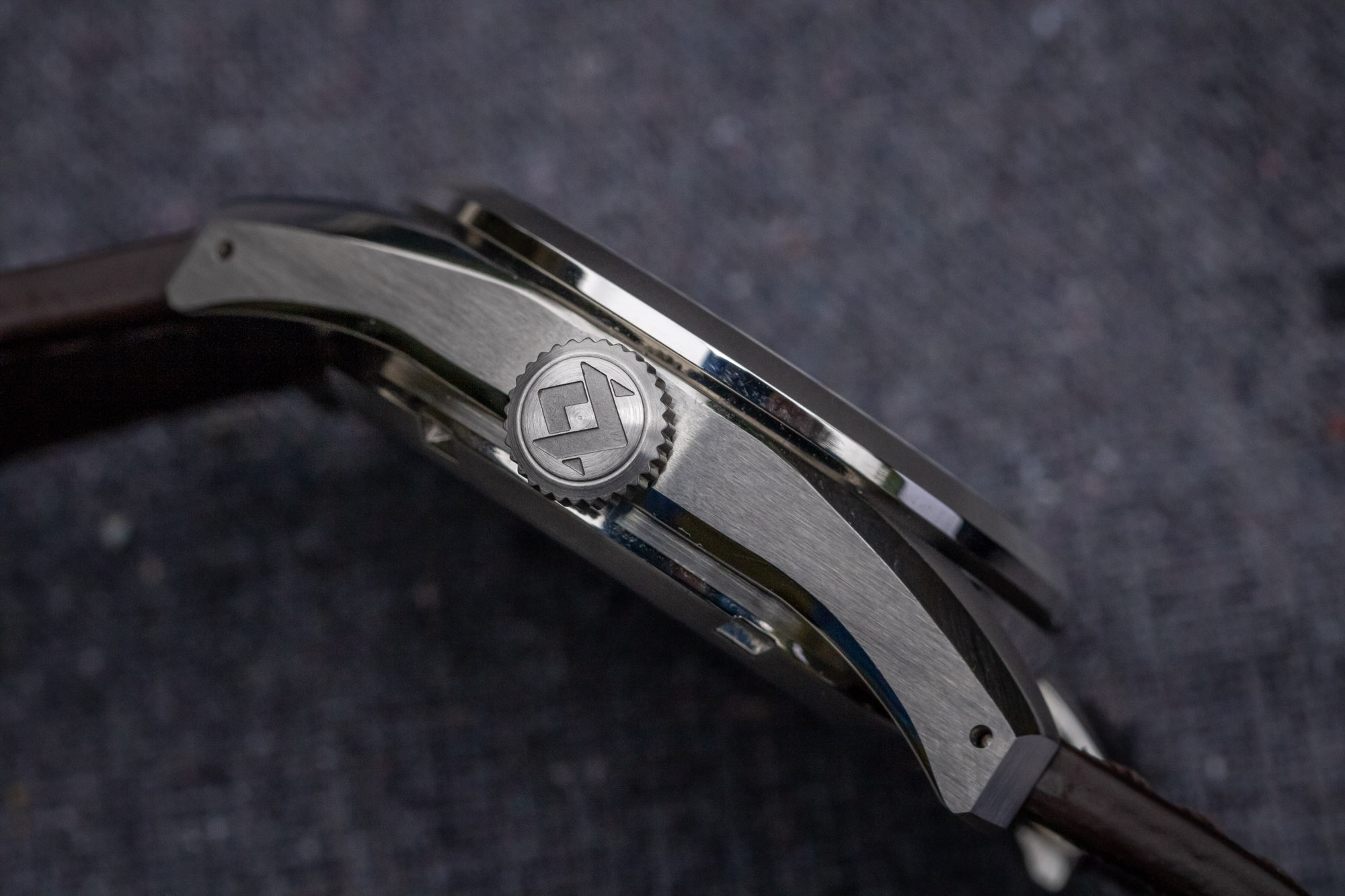
Fitted to the top of the case is a smooth fixed bezel that features a radially brushed angled surface sandwiched between high-polished sides and a thin polished rim on its top edge. Inside the bezel sits a scratch-resistant sapphire crystal that features a flat top surface with a domed underside, and it includes blue anti-reflective treatment on the underside for reduced glare in harsh lighting conditions. The shape of the crystal offers a lot of the same visual intrigue as a traditional double-domed crystal, although since its external surface is ultimately flat and sits flush with the bezel, it is less likely to bump into things and pick up marks and scratches.
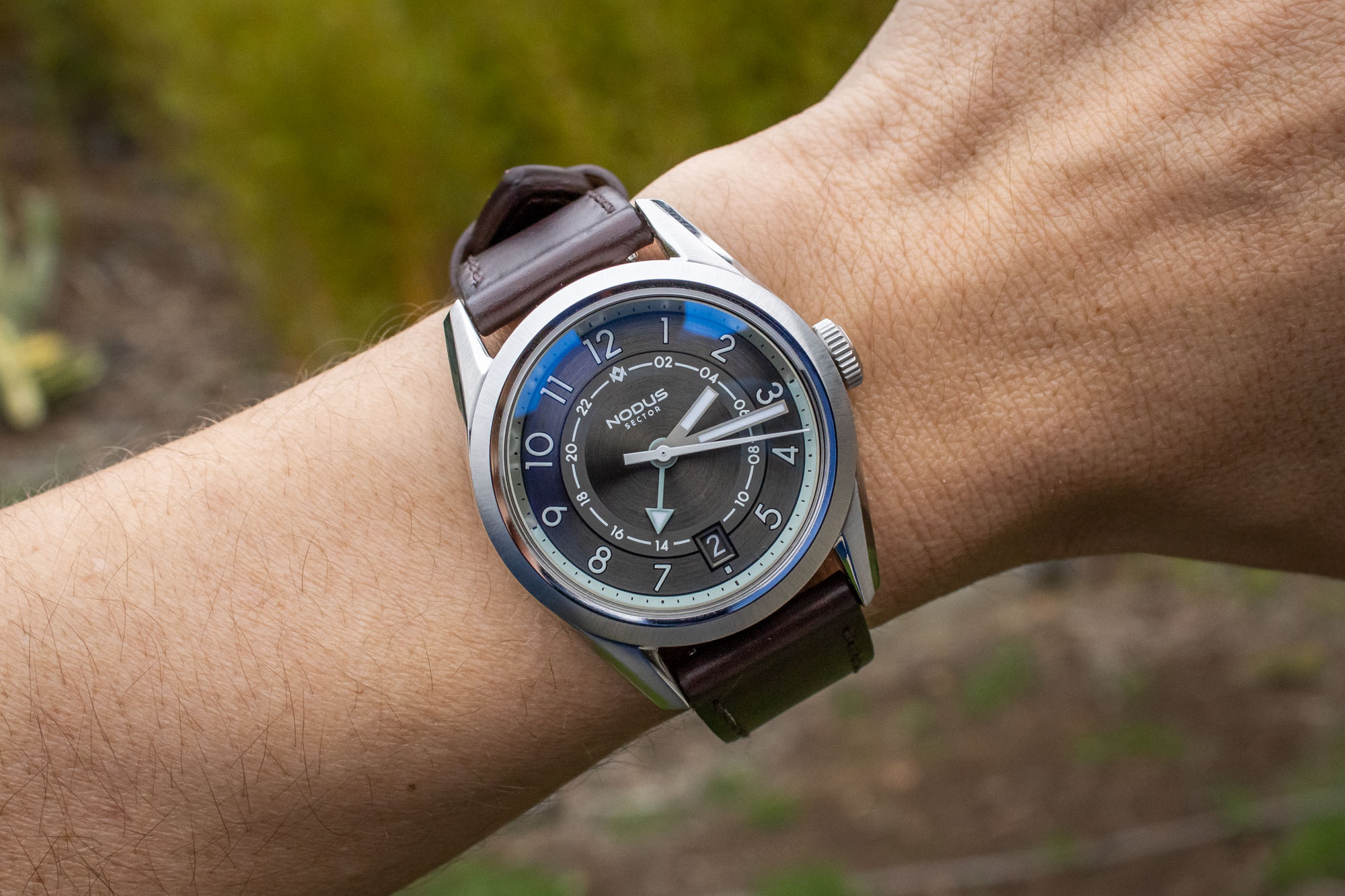
At the 3 o’clock location sits a large flat winding crown with fluted sides that is signed with the Nodus logo, and it screws down to the case to help create 100 meters of water resistance. Meanwhile, the reverse side of the case gets fitted with a solid stainless steel screw-down caseback that is virtually identical to the style found on other Nodus Sector watches, and it features all of the expected markings, along with an engraving of the Sector series logo, which consists of four overlapping circles that have somewhat of a Venn diagram appearance. With crisp lines and clean transitions between the various brushed and polished surfaces, the finishing on the Nodus Sector GMT is quite a bit better and more involved than what you might expect to find on a watch that costs just several hundred dollars, and it strikes a nice balance that is neither overly casual nor too formal.
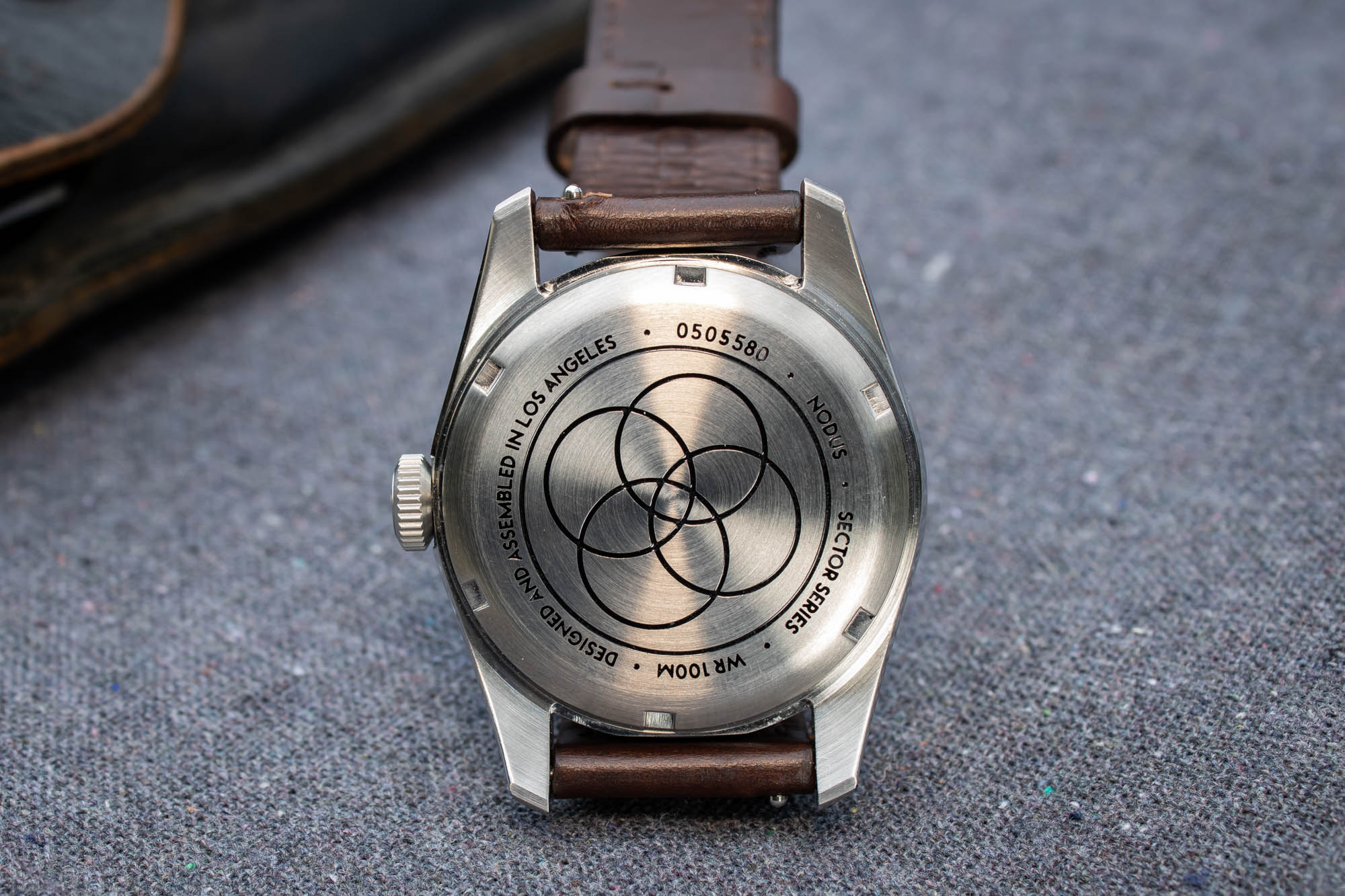
The dial of the Nodus Sector GMT offers an inherently modern overall appearance with radially-oriented Arabic numerals and a date window at 6 o’clock. The overall style of the dial is somewhat similar to that of a classic field watch; however, it features a secondary 24-hour scale located on the interior of its hour markers, which works with the GMT hand to create an additional timezone display. The entire dial features a circular brushing pattern, with the one exception being the small ring that contains the 24-hour scale. A groove surrounding the periphery of the ring helps highlight its contrasting surface finishing, and this subtle circular motif on the dial works with the radially-oriented numerals to create a very cohesive and contemporary overall appearance.
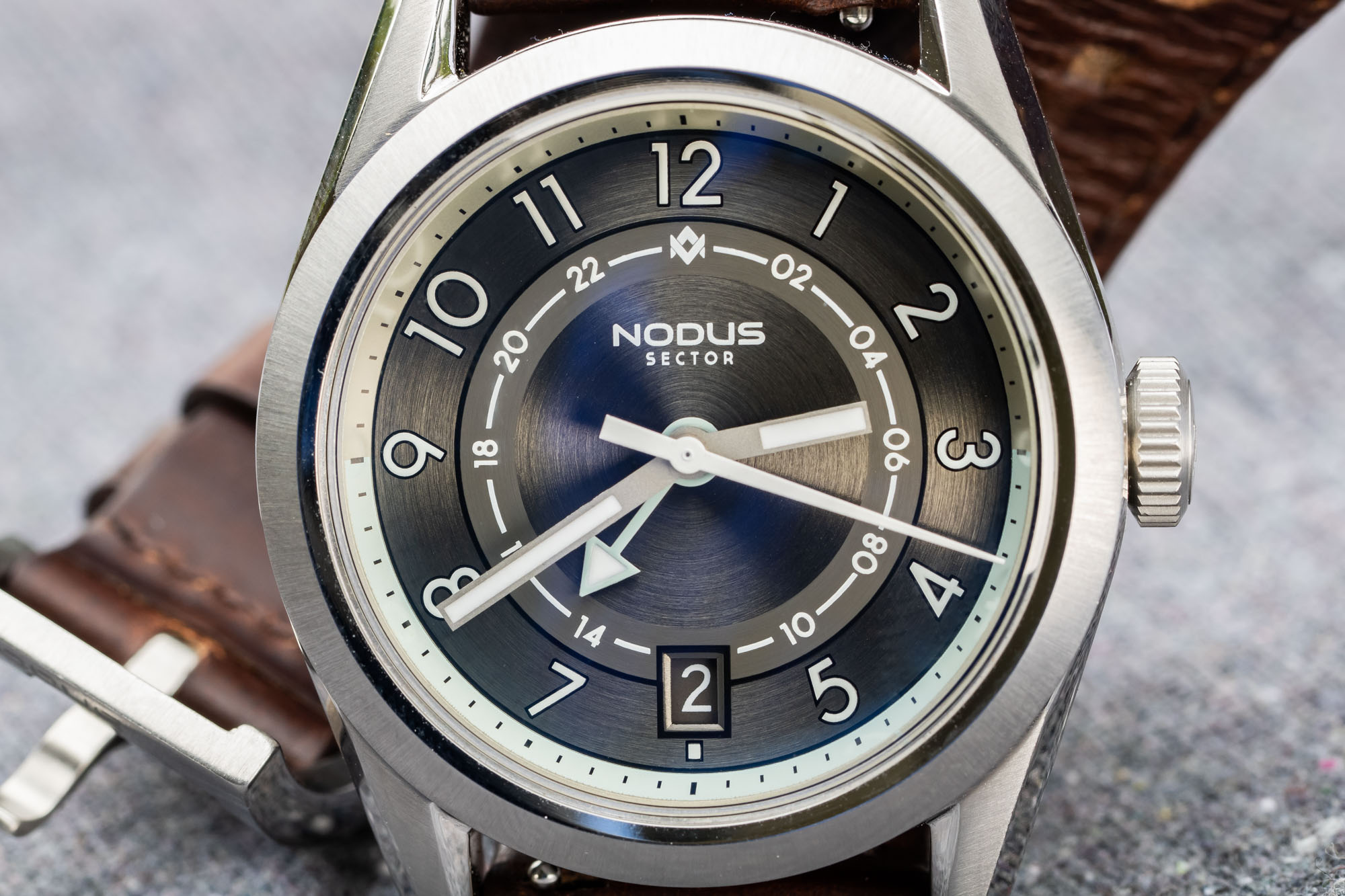
Surrounding the dial is a steep angled rehaut that contains the minute track printed in black, and it features a split-color surface finish to help offer a rough approximation of day versus night hours. On the Metro version of the Sector GMT, the top half of the rehaut appears in a light silver color to complement the anthracite gray surface of the dial, while the lower half is finished in a pale ice blue tone that adds a subtle dash of color to the face of the watch while still maintaining its restrained and largely monochromatic aesthetic.

At the center of the dial are four hands that are tasked with displaying the time in both of the two timezones, and they continue the colorway and modern aesthetic that are established by the rest of the watch. On the Metro version of the Nodus Sector GMT, the hour and minute hands are matte silver batons, while the seconds hand appears as a tapered white needle, and the small arrow-shaped GMT hand gets finished in the same pale blue color as the lower half of the rehaut. The hour, minute, and GMT hands all receive luminous inlays, and both the hour markers and the secondary 24-hour scale are finished with blue-glowing Swiss Super-LumiNova T-C1 X1 for a clear display of the time in the dark.
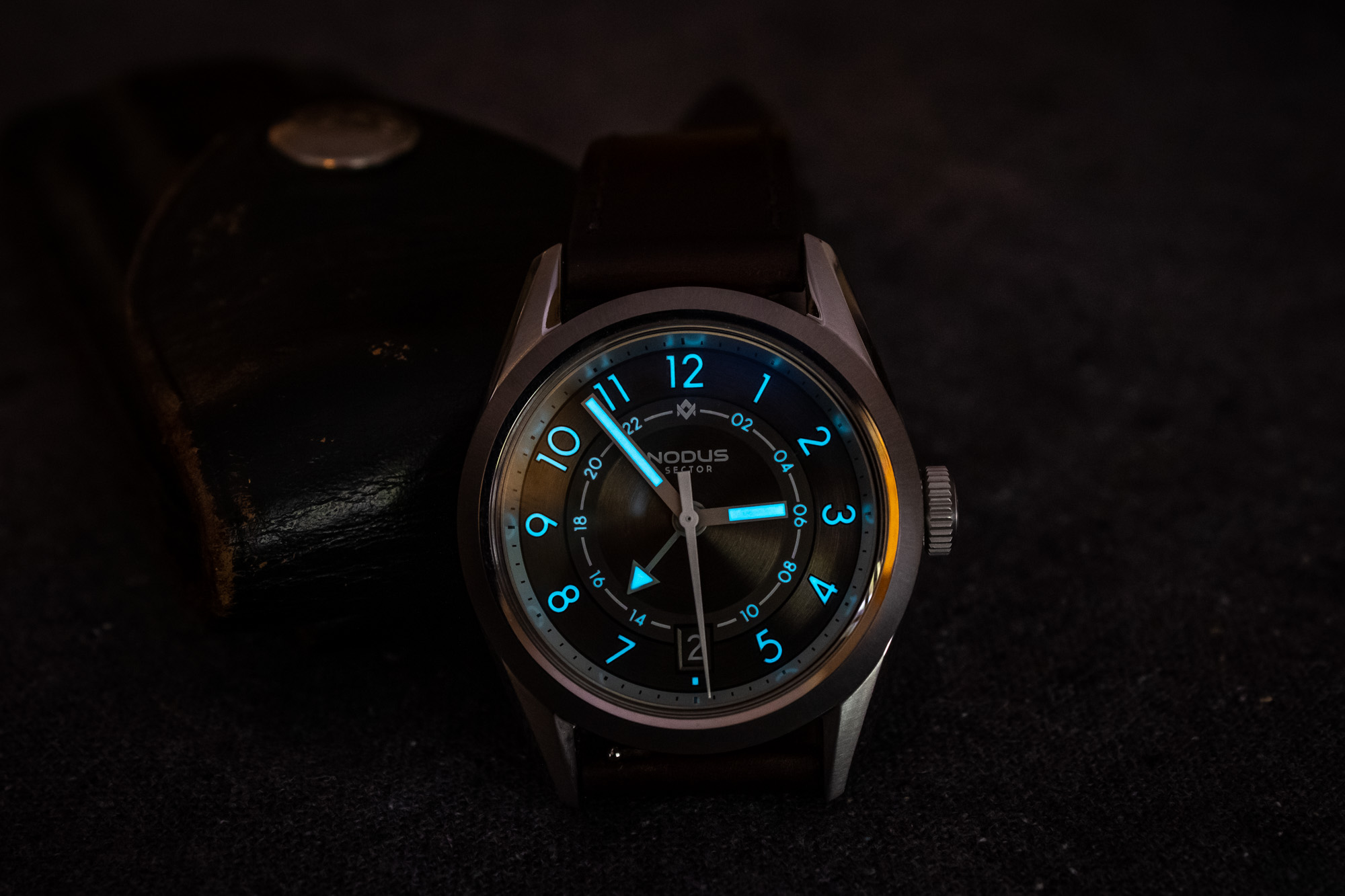
Although the Nodus Sector GMT doesn’t have any issues with legibility, I do wish that the minute hand was just a tiny bit longer. I’m not even entirely convinced that it is actually too short, but rather that the combination of its completely flat tip and the minute track being located on the rehaut make it seem a bit stubby, simply because it doesn’t reach all the way to the minute track markings. Even still, the difference in length between the hour and minute hands is enough that you won’t have any trouble telling the two of them apart, and having the minute track printed upon the rehaut rather than the dial surface itself ultimately helps create a much cleaner overall display.
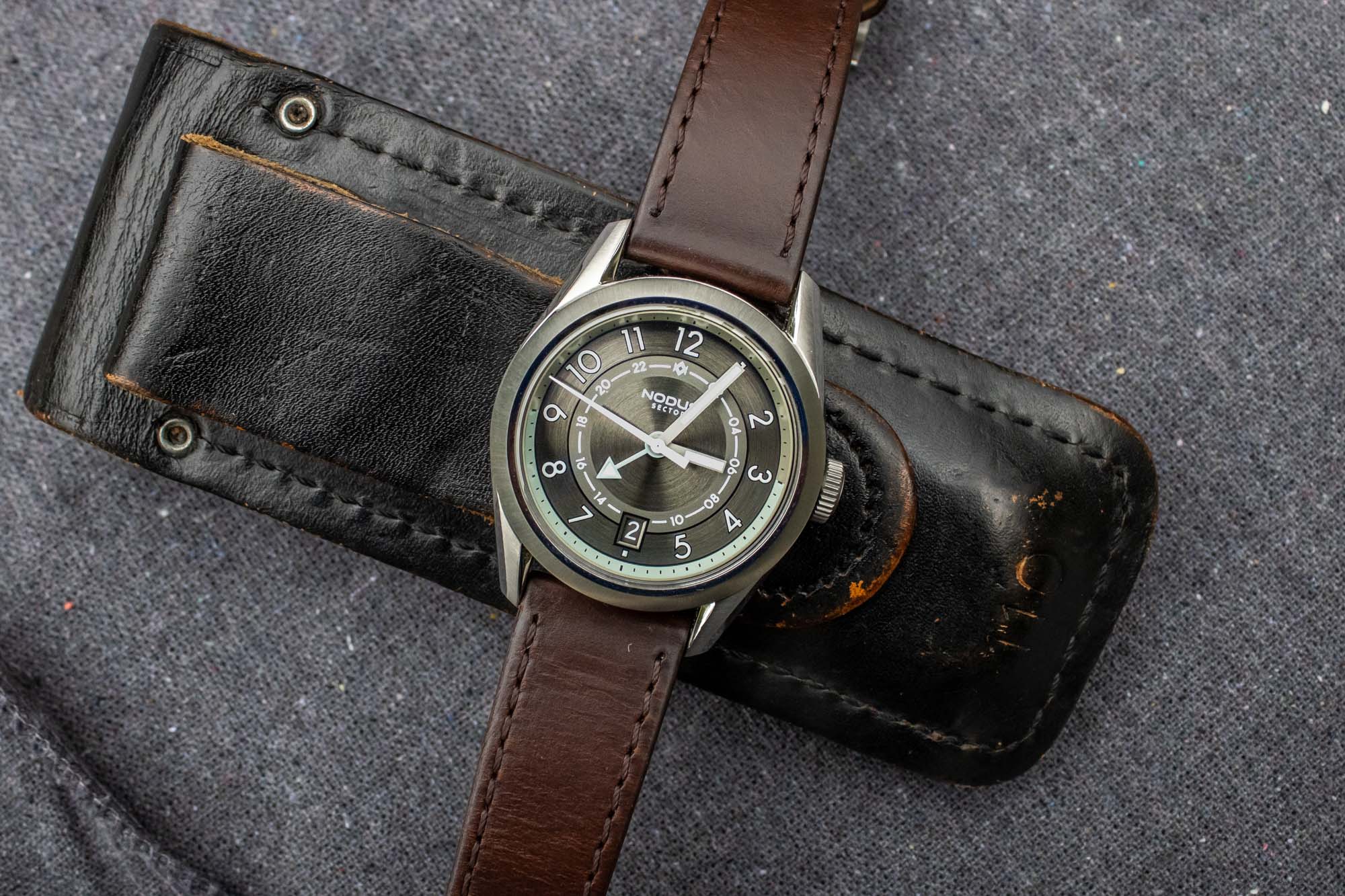
Powering the Nodus Sector GMT is the Seiko NH34 automatic movement, which is the version of the 4R34 that Seiko sells to third parties for use inside non-Seiko watches. Like many other entry-level mechanical Seiko calibers, the NH34 runs at a frequency of 21,600vph (3 Hz) and offers users a power reserve of approximately 41 hours. Although the NH34 is a proper GMT movement with independently adjustable hour hands, it is the 24-hour hand that can be set independently from the time, rather than being the variety that is capable of having its local 12-hour hand adjusted either backward or forward in one-hour increments.
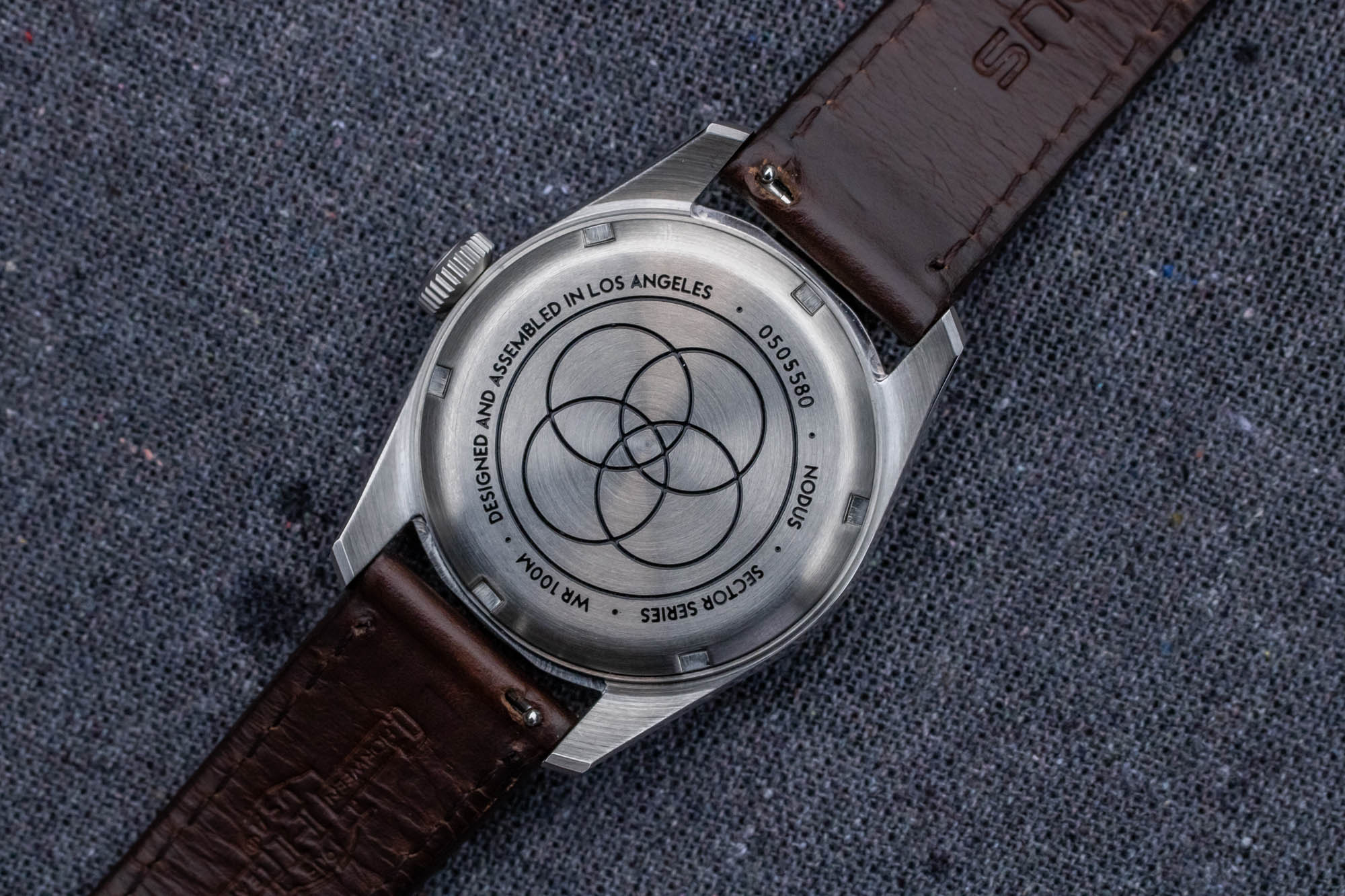
While the official specs for a standard Seiko NH34 are a rather unimpressive +40/-20 seconds per day, Nodus further regulates the NH34 movements that it uses for the Sector GMT, and the model is therefore accompanied by a significantly better accuracy rating of +/- 10 seconds per day. Although this is already far better than what is offered by a standard Seiko NH34 movement, I found real-world performance to be even a bit better than the listed specs, and the example that I was sent for review only gains a handful of seconds each day. Expectations always need to be reasonable when it comes to the accuracy of budget-friendly mechanical calibers, although Nodus does a very good job at making sure that the NH34 movements inside the Sector GMT run as well as they can, given the watch’s highly affordable price point.
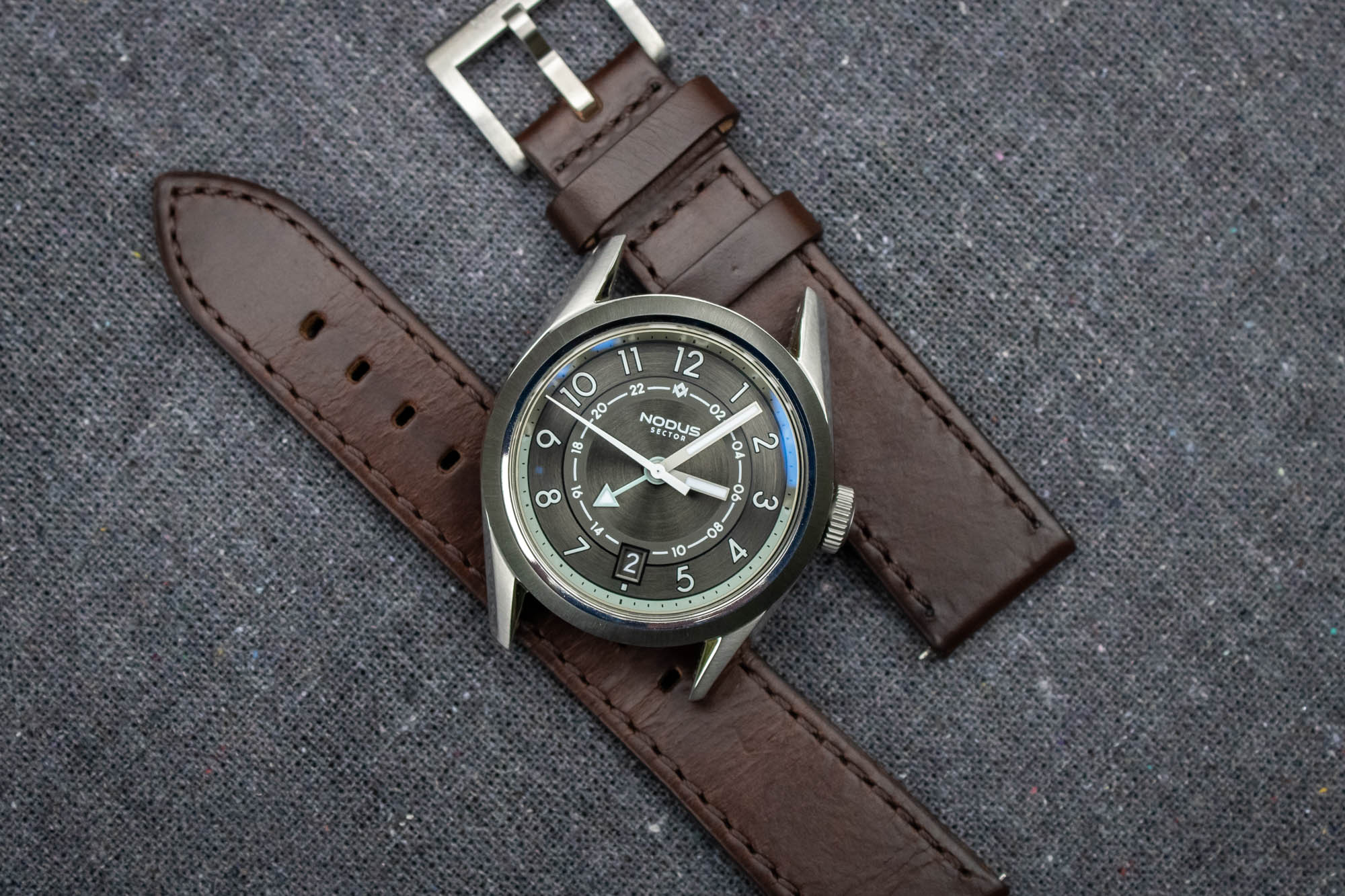
Unlike the rest of the models from the Sector series, which are all fitted with various styles of metal bracelets, the Nodus Sector GMT is exclusively offered with a leather strap. Despite the fact that I don’t often wear leather straps, I can certainly appreciate a good one, and the leather strap fitted to the Sector GMT is pretty fantastic considering the price of the watch. Crafted from brown Horween leather and fitted with integrated quick-release spring bars at the lugs and a chunky signed pin buckle to connect the two ends together, the Sector GMT strap is incredibly soft and comfortable right out of the box, and it was able to immediately conform to the shape of my wrist with virtually zero break-in period required.
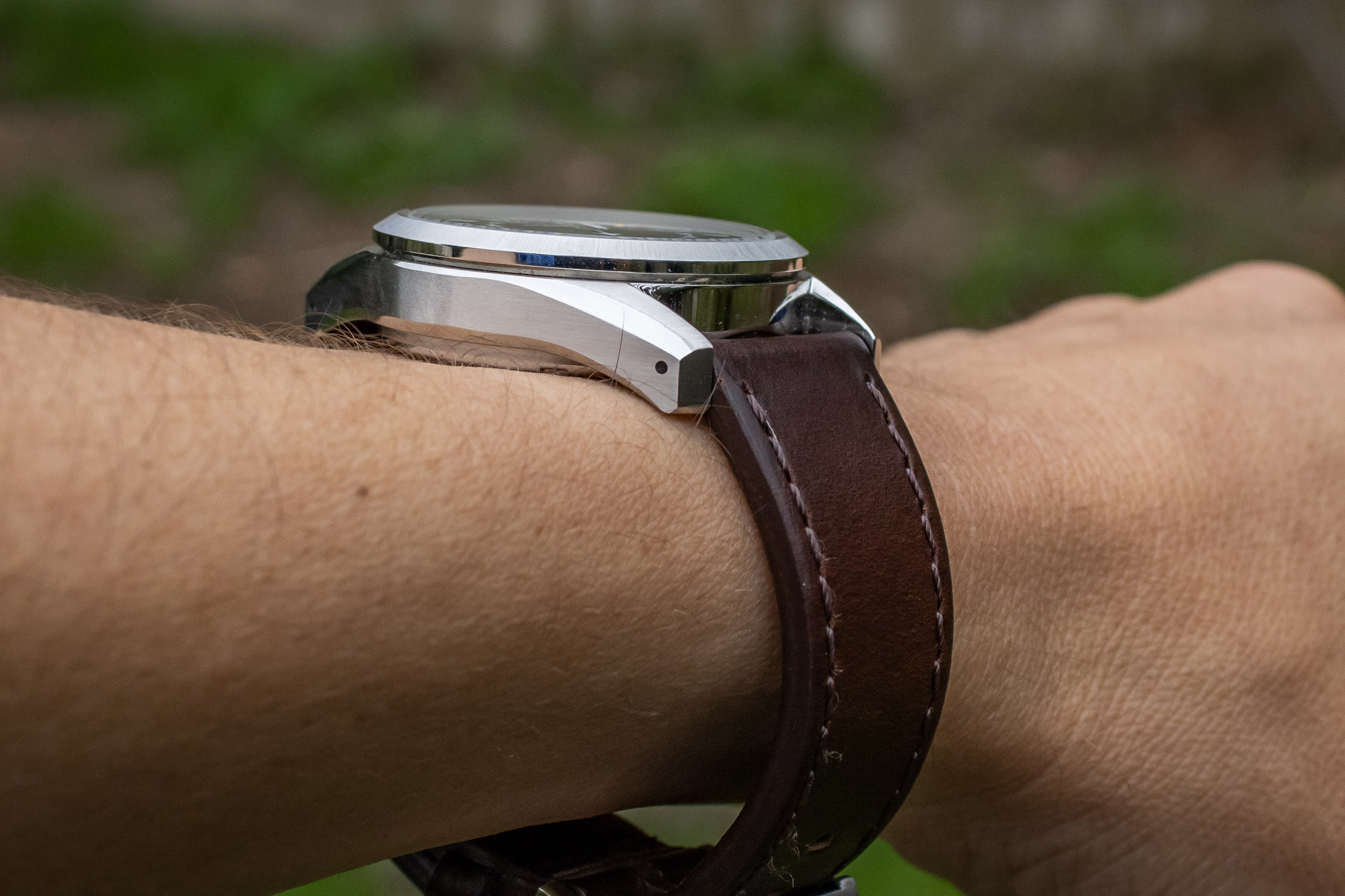
While the strap for the Pacific version of the Sector GMT is a light golden brown color, the Metro colorway receives a dark espresso-colored strap to better complement its more understated and paired-back overall aesthetic. I had no idea Nodus leather straps were this good, and this exact same strap could easily exist on a watch priced at several thousand dollars without even seeming slightly out of place. The fact that a strap of this quality is included on a watch that only costs several hundred dollars is certainly a nice touch, although given how much attention Nodus gives to its metal bracelets and clasps, it’s hardly surprising that the brand’s leather straps also significantly exceed expectations at this firmly accessible price point.
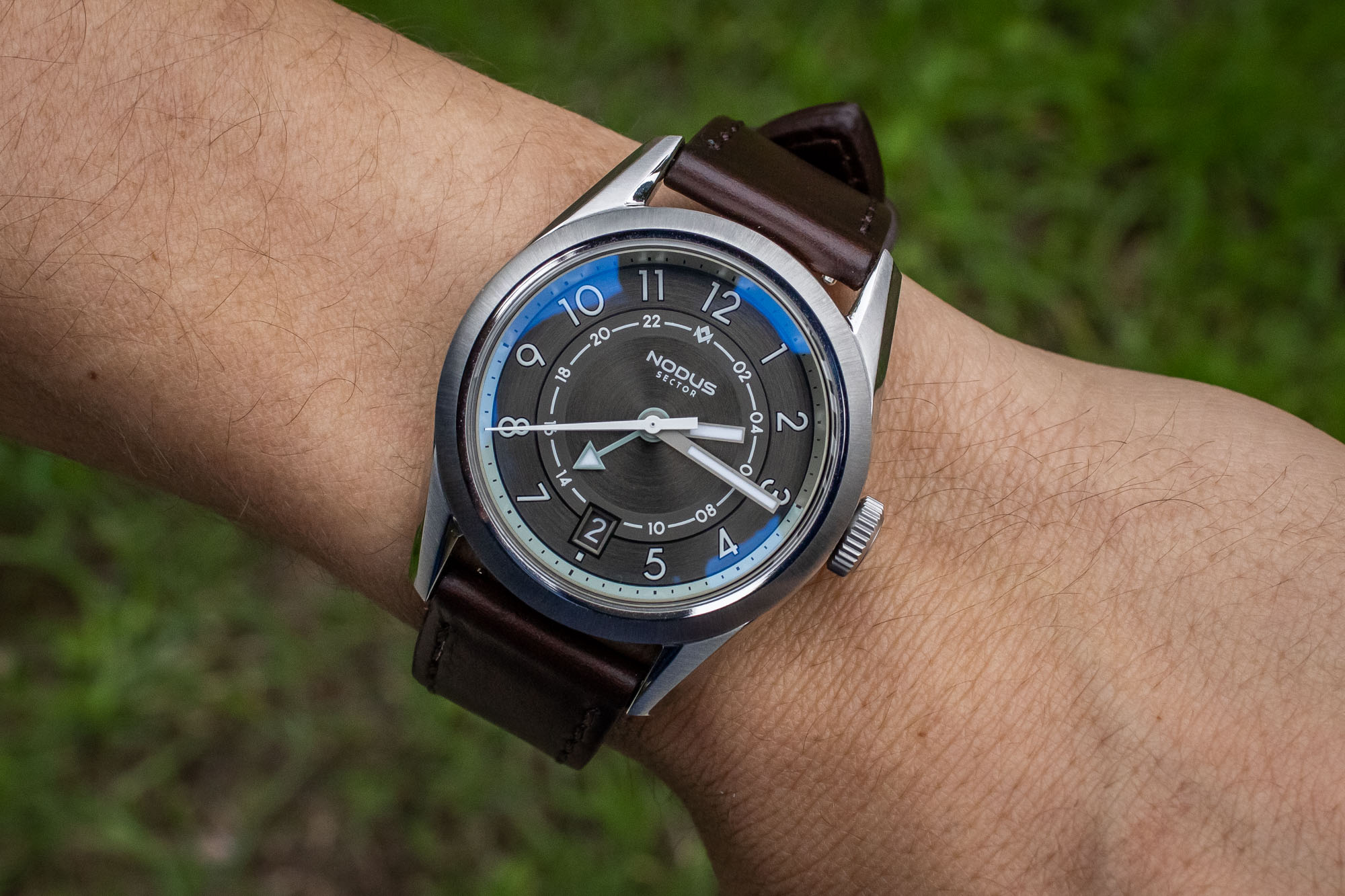
In terms of both aesthetics and functionality, the Nodus Sector GMT is probably my favorite model from the Sector series that Nodus has released thus far. Given that most GMT watches embrace rather sporty designs, the distinctly modern and refined appearance of the Nodus Sector GMT is a refreshing reprieve from the rotating bezels and chunky crown guards that typically accompany GMT watches on the more affordable end of the price spectrum. Additionally, just by looking at its specs and the fact that it is produced by a small-scale independent brand, it would be easy to assume that the Nodus Sector GMT would be more expensive than the Seiko 5 GMT, which uses the same movement, yet the Sector GMT has an official retail price of just $450 USD, making it even more affordable than the Seiko, and a highly compelling value proposition when it comes to budget-friendly mechanical GMT watches. At this price point, it’s hard to nitpick too hard, although the Nodus Sector GMT really doesn’t give me too much to nitpick about at all, and it offers an excellent alternative to the overtly sporty models that make up the majority of the affordable GMT watches currently available today. For more information on the Nodus Sector GMT, please visit the brand’s website.

